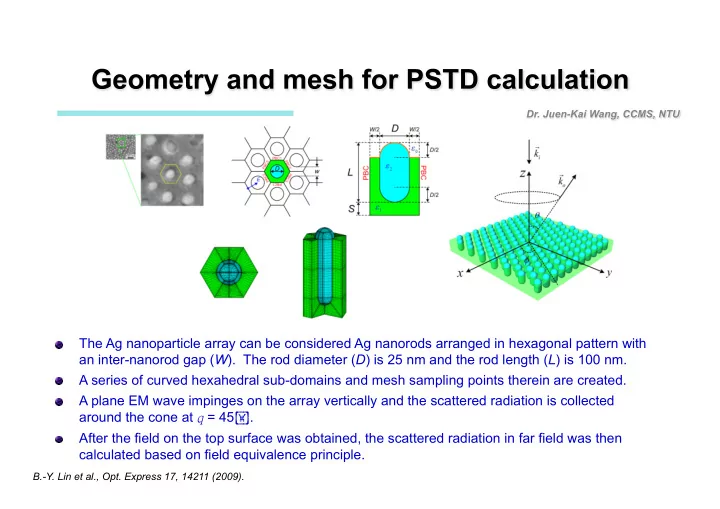

The Ag nanoparticle array can be considered Ag nanorods arranged in hexagonal pattern with � an inter-nanorod gap ( W ). The rod diameter ( D ) is 25 nm and the rod length ( L ) is 100 nm. A series of curved hexahedral sub-domains and mesh sampling points therein are created. � A plane EM wave impinges on the array vertically and the scattered radiation is collected � around the cone at q = 45 � . After the field on the top surface was obtained, the scattered radiation in far field was then � calculated based on field equivalence principle. B.-Y. Lin et al., Opt. Express 17, 14211 (2009).
The calculated far-field spectra follow the experimental data qualitatively: The resonance � wavelength increases and the width is broadened as the interparticle gap decreases. B.-Y. Lin et al., Opt. Express 17, 14211 (2009).
For all the different interparticle gaps, the far-field scattering is dominated by surface electric � current density ( J ) which is generated by surface magnetic field, according to field equivalence principle. In contrast, surface magnetic current density ( M ), generated by surface electric field, plays a � minor role in far-field scattering. B.-Y. Lin et al., Opt. Express 17, 14211 (2009); S. R. Rengarajan and Y. Rahmat-Samii, IEEE Antennas Propagat. Mag. 42, 122 (2000).
The surface electric field is localized at the gap region between adjacent Ag nanoparticles. � The surface magnetic field is delocalized over the whole surface and produces the corresponding � J that acts as the dominant source of the far-field scattering. The so-called “hot spots” created by the localized surface electric field has a minor role in � producing far-field scattering. B.-Y. Lin et al., Opt. Express 17, 14211 (2009).
Electric field resides within the gap and exhibits an evanescent character. � Magnetic field delocalizes over the surface and shows mainly a propagating character. � In surface-enhanced Raman scattering, the localized surface electric field interacts with the � molecules residing in the gap region, producing a similar electric field distribution at a Raman- shifted wavelength. The resultant concurrent surface magnetic field then makes a major contribution to produce Raman scattering field in far distance. B.-Y. Lin et al., Opt. Express 17, 14211 (2009).
� Raman spectroscopy, providing molecular vibrational information, can become a powerful and useful method to identify molecular species if its scattering cross section can be enhanced many orders of magnitude. � Surface-enhanced Raman scattering (SERS) may serve as the solution. � Most of Raman enhancers have suffered two major drawbacks: low reproducibility and small dynamical range. Therefore, a lot of efforts have been made to control its enhancement mechanisms such that uniform high sensitivity can be achieved. � One key point is whether it is possible to control precisely the electromagnetic enhancement factor induced by plasmonic resonance. � Theoretical and experimental studies indicate that the precise control of gaps between nanostructures in the sub-10 nm regime, ‘hot junctions’, is likely to be critical for the fabrication of SERS-active substrates with uniformly high Raman enhancement factor.
These substrates are commercially available. � T.-T. Liu et al., PLoS ONE 4, e5470 (2009).
Staphylococcus aureus 13649 treated with vancomycin Drastic change in SERS spectra was observed when treated with vancomycin. � T.-T. Liu et al., PLoS ONE 4, e5470 (2009).
Inhibition of Cell Wall Synthesis (most common mechanism) Inhibition of Protein Synthesis (second largest class) S. Aureus responds within 2 hrs to the antibiotics which inhibit cell-wall synthesis, while the � response is delayed to longer than 8 hrs. for that which inhibit protein synthesis. T.-T. Liu et al., PLoS ONE 4, e5470 (2009).
� Scattering-type SNOM has been demonstrated to serve as a nanoprobe to investigate local optical properties and to probe local field distribution. � The uniform and highly reproducible SERS-active properties and the wide dynamical range facilitate the use of SERS for chemical and biological sensing applications with high sensitivity. � The electromagnetic interaction in arrays of Ag nanorods embedded in AAO has been investigated thoroughly by both experimental and theoretical methods.
Recommend
More recommend